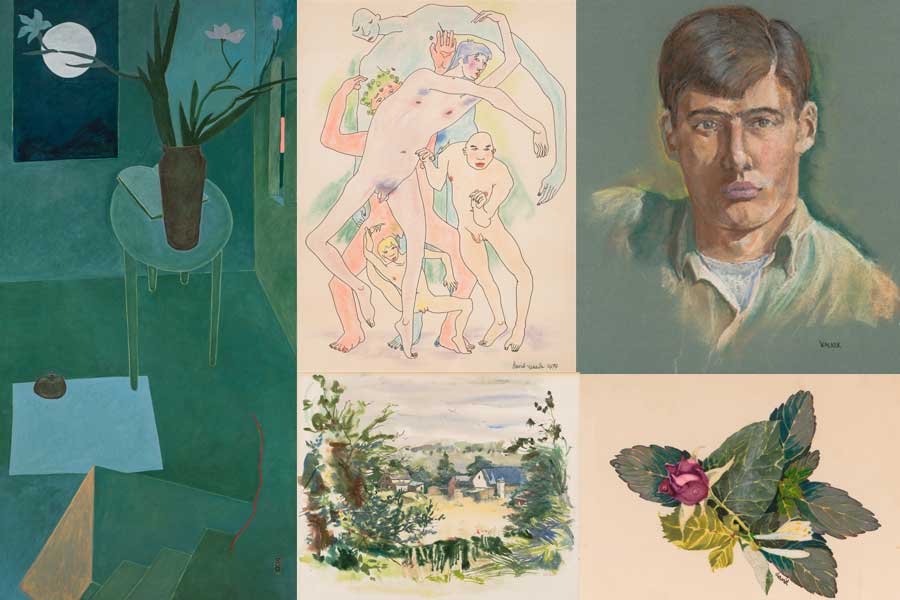The William Way LGBT Community Center is set to host a retrospective exhibition celebrating the life and works of gifted out artist and Pennsylvania native David Meade Walker.
Born in 1948 in Lancaster, Walker excelled in art from an early age and went on to get a degree in art history from Indiana University of Pennsylvania before relocating to San Francisco, where he passed away in 2012.
Walker’s sister, Sharon Eisenhour, inherited his artwork and soon became interested in finding an appropriate place to put his talents on view to the public.
“I got all of his art so I was talking to some of my friends about finding a place to show his work,” Eisenhour said. “It’s beautiful work and I don’t want it to sit in my basement or attic. A friend of mine was part of the founding of the William Way Center. My friend said, ‘You’ve got to go to the William Way.’”
Eisenhour spoke with center executive director Chris Bartlett, whom she said loved the idea, and they got to planning.
Eisenhour was expecting the center to only be interested in a few pieces for inclusion in its gallery space but, once she met with the gallery’s coordinators and they heard Walker’s story and saw his artwork, they expressed interest in hosting a full exhibition.
“They asked, ‘Do you think you have enough to fill the whole space?’ which they don’t often do,” Eisenhour said. “They liked the whole concept and the story and the art. I said, ‘Yes, I do.’ I’ll bring a lot of what I have but we won’t hang it all because there is not enough space.”
Eisenhour said that, even though he spent most of his life in San Francisco, Walker’s artwork often reflected the aesthetics of his upbringing.
“We grew up in Amish country,” she said. “We bought our land from Amish people. We were surrounded by them so we grew up completely in the country. We ran around, rode on our bikes, went in the creeks and played in their barns. It was a very rural childhood all the way through until we went away to college. [The setting] greatly influenced him. He does beautiful landscapes and I have some of that area that will be in the show. In San Francisco, he worked more on developing his own style. He did a lot of portraits once he lived out there.”
Eisenhour said Walker’s work covered a wide range of styles, subjects and disciplines from the beginning.
“It’s really curious,” she said. “You’re not going to be able to look at a piece and say, ‘Oh, that’s a David Walker.’ You just can’t because he worked with so many different media and it seemed like he did them all really well. There’s no one area where you can say, ‘This is what he liked and did the most.’ It’s equally distributed between pen and ink, pastels and he did watercolors beautifully. He did oils and sculpting. He did everything. I’m a fierce patron of his art.”
Eisenhour said she and Walker, who was only a year younger than her, were always very close.
“I’ve grown up seeing him create and draw. I just love it and I see how people react to it. It’s worthy.”
Eisenhour plans to develop a website devoted to Walker’s work and to continue finding galleries in which to showcase it.
The work on display at William Way is available for sale. Eisenhour said she hopes that art lovers will discover and appreciate Walker’s works as well as the unique life experiences that shaped them.
“I hope this sparks somebody to collaborate with me on some bigger project,” she said. “I always say if they can do a movie about the Dallas Buyers Club they could maybe do a documentary or book about this guy. Here’s a guy who had a rural upbringing. He went his own way. He had conscientious-objector status during Vietnam. He worked in a hospital in the Boston area. Then he went to what he called the ‘candy store’: He moved to San Francisco in 1978. He loved it, loved it, loved it. Once he smelled the eucalyptus leaves, he said, ‘I’m home.’”
In the early 1980s, Walker tested positive for HIV.
“He was one of the first to really get hit,” Eisenhour said. “And by 1988, he was officially diagnosed with AIDS and then he got KS [Kaposi’s sarcoma], and he went though all that shit all those years and he never gave up. He kept creating art. He wasn’t prolific but he kept doing things. And he just showed everyone around him. He showed us how to live in the face of all that adversity. One more thing would happen to him and he would say, ‘Well, there goes the fender.’ And he would just chuckle, roll up his sleeves and say, ‘What are we going to do about that? Let’s see how that part of the disease works. Let’s see how we can treat it or work around it.’ It was just that spirit and that joy. The last visit I had with him at his apartment he said, ‘The light is still in the eyes, isn’t it?’ He just kept on keeping on. It was a beautiful example of how to live. And he simplified over the years. He just kept getting more and more simple, more of a Zen existence and letting things go. Possessions, they didn’t matter to him. He didn’t live in poverty; he had a nice apartment but it just didn’t matter. He found more of the essence of life the longer he lived and he really taught that in a subtle way to everybody that knew him.”
William Way LGBT Community Center hosts a retrospective exhibition of the works of David Meade Walker Sept. 9-Oct. 30, 1315 Spruce St. For more information, visit www.waygay.org or www.facebook.com/events/1571218476515313/.
